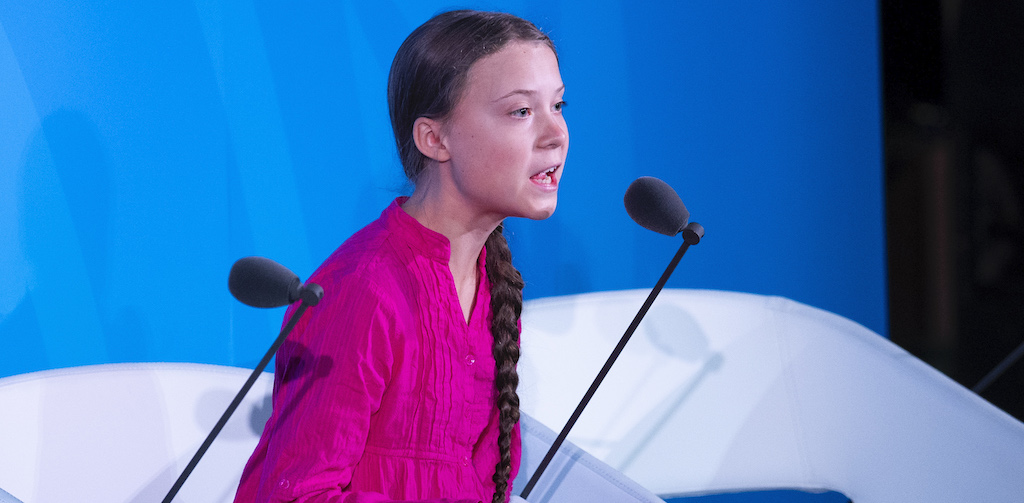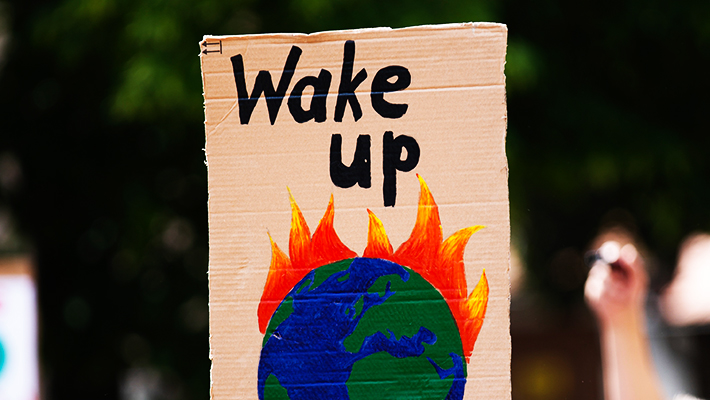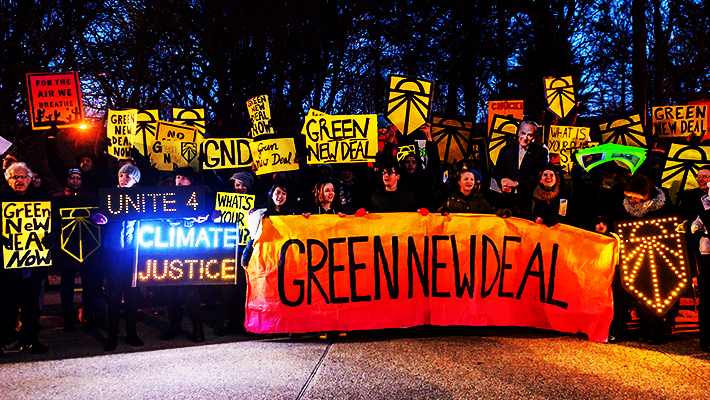At the United Nations General Assembly, only one day before President Donald Trump gave a speech maligning globalism, 16-year-old activist Greta Thunberg spoke about climate change at the Climate Action Summit. Her speech was full of righteous anger, directed at the political leaders who have applauded her activism while simultaneously dragging their feet when it comes to implementing meaningful climate policies.
“People are suffering. People are dying. Entire ecosystems are collapsing,” Thunberg said. “We are in the beginning of a mass extinction, and all you can talk about is money and fairy tales of eternal economic growth. How dare you! For more than 30 years, the science has been crystal clear. How dare you continue to look away and come here saying that you’re doing enough, when the politics and solutions needed are still nowhere in sight.”
Thunberg’s fury — aimed at short-sighted, greedy politicians and industrialists — is a defining trait of the youth-led climate justice movement. It’s the drive behind the recent four million-strong global climate march and youth-led demands for a Green New Deal.
So what is climate justice? We break down the growing movement and how you can help.
What is climate justice?
Climate change is the issue of our era. As we wrote previously, “climate change is directly affecting migration patterns; a vast number of environmental disasters directly impact people of color and poor people in the U.S.; and you can’t talk about health care without talking about how climate change is going to worsen health outcomes for many Americans.” According to the U.N., “The impacts of climate change will not be borne equally or fairly, between rich and poor, women and men, and older and younger generations.”
This is where climate justice comes in. It is, first and foremost, a framework. It’s a means of understanding the impact human-caused climate change is having on the world: that climate change is not just a vacuum-sealed matter of ecology and the environment, of melting ice caps and polar bears struggling to survive in far-flung places, but a political and social issue that has and will affect everyone, but especially those most economically and politically vulnerable.
When you look at the effects climate change is having on hurricanes, for instance, using a climate justice framework acknowledges that these ever-more disastrous storms are having an outsized impact on poor communities. Take 2017’s Hurricane Maria, for example. Puerto Rico was ravaged by the storm, and many people living in the interior are still using tarps instead of roofs and struggling to rebuild, while areas with more money are well on their way to recovery.
Climate justice is also a call for equitable and radical change that holds powerful polluters accountable and protects vulnerable nations and people from the worst consequences. Taking Maria as an example yet again, were the U.S. government to use a climate justice framework to develop policies, they would have provided more disaster relief funding — and provided more funding to rebuild infrastructure in order to prevent future disaster on the same scale.
Who are the young activists fighting for climate justice?
Fiery speech by Thunberg aside, the U.N. Climate Action Summit left youth activists wanting more. According to VICE, one 19-year-old attendee who helped organize the New York climate strike said, “We had a useful discussion, just not through the U.N. And nothing here produced anything tangible that could be handed to our world leaders on Monday from the youth movement.”
The climate justice movement is, above all else, youth-led and action-oriented. Here are just a few faces leading the charge.
Greta Thunberg

There’s a reason Thunberg has become, in many ways, the face of the youth-led climate justice movement. In August 2018, she started a one-person protest on the Swedish Parliament steps in Stockholm, standing for three weeks with a sign demanding action. Her action inspired a global strike last March in which more than 1.4 million people participated, and during a climate summit in Poland in December 2018, she said, “I don’t care about being popular. I care about climate justice and the living planet.”
In her recent U.N. speech, Thunberg warned political leaders, “You are failing us. But the young people are starting to understand your betrayal. The eyes of all future generations are upon you. And if you choose to fail us, I say: We will never forgive you. We will not let you get away with this. Right here, right now is where we draw the line. The world is waking up. And change is coming, whether you like it or not.”
And while Thunberg is far and away the most recognizable face, thanks to what started as a one-person protest in her Swedish hometown, she’s not the only person fighting for justice.
Amariyanna Copeny a.k.a. Little Miss Flint
No, our fight to save the planet didn't start today with the #ClimateStrike and it doesn't end today either. Many of us have been putting in the work for years to save our planet. Don't just amplify our voices today, but every day and support our solutions to save us.
— Mari Copeny (@LittleMissFlint) September 21, 2019
In the more than five years since the Flint Water Crisis became national news, now-11-year-old Copeny has done a lot: in 2016, she got then-President Barack Obama to not only visit Flint but promise $100 million in grants to fix the water system, handed out water bottles and school supplies to Flint residents, raised hundreds of thousands of dollars, and continually brought attention to the ongoing crisis.
And while Flint’s water is cleaner than it was when the crisis gained national attention, according to Michigan Radio, as of 2015, “the city’s lead service lines continued to leach lead into residents’ drinking water.” Of the 20,000 lines, approximately 8,000 have been replaced. Copeny’s Twitter and Instagram presence is a persistent reminder that Flint is not out of the woods yet — which keeps people outside of the region focused on the ongoing struggle. Copeny has also used her platform to broaden her reach, advocating for all manner of social justice causes, including the Global Climate Strike. Copeny’s work engages with the systemic racism at the heart of so many disastrous environmental policies, and it’s an important groundwork for advocating for climate justice, which also acknowledges how systemic racism deeply affects those who suffer most from climate change.
Autumn Peltier
Peltier is a 15-year-old member of the Anishinaabe tribe from the Wikwemikong First Nation, a water activist, and the newly appointed Anishinabek Nation Chief Water Commissioner. The fact that Peltier is First Nations is important: colonialism saw Indigenous people around the world have their lands and water stolen by colonizers and governments.
In a 2018 speech at the U.N. General Assembly, Peltier said, “My heart is not for sale, and neither is our water or our lands.” She outlined the need to protect water from pollution, poor sanitation, and climate change. Her activism goes hand-in-hand with the U.N. Human Rights Committee’s recent assertion that access to clean water is a human right.
What does this have to do with climate justice? Not only is climate change have a direct, negative impact on the water cycle (think of how extreme weather events like hurricanes or droughts affect access to clean water), but “growing demand for water is leading to an increase in energy-intensive pumping, treatment and transportation, thereby raising carbon emissions and exacerbating climate change.”
Artemisa Xakriabá
At the New York climate march on Friday, September 20, Indigenous Brazilian activist Xakriabá, who is a member of the Xakriabá tribe, told Buzzfeed News, “We have to resist to exist.” And that is what she is doing with her work to save the Brazilian rainforest from capitalism-driven deforestation.
She is a representative for the Global Alliance of Territorial Communities, a collective of Indigenous peoples who are fighting to protect their land. And at a September 17 briefing, she told reporters, “Right now, the Amazon, home to millions of my relatives, is burning […] The governments of Brazil and the United States are not helping. They promote hate-based narratives and a development model that attacks nature and Indigenous peoples. These governments are trying to put us in extinction. They are part of the problem.”
Her work to save the Amazon from deforestation is akin to attempting to save the lungs of the Earth.
The Sunrise Movement
The Sunrise Movement is more than just one face. It’s a U.S.-based youth movement fighting to implement the Green New Deal, a radical policy framework that would completely overhaul the U.S. economy and achieve net-zero emissions within a decade. Members of the Sunrise Movement have taken over Congress members’ offices, held training boot camps for eager newcomers, and helped make climate change a front-and-center political issue.
It’s not a formal group with official membership, but according to Vox, leaders of the movement estimate that “15,000 young people have showed up to in-person actions across the country and that 80,000 have participated in less direct actions such as emailing and calling their representatives.”
What can you do to help?

Former President of Ireland Mary Robinson told the U.N., “Now, thanks to the recent marches, strikes and protests by hundreds of thousands of schoolchildren, we have begun to understand the intergenerational injustice of climate change.”
But understanding isn’t quite enough. You also need to act. Here’s how.
Get involved.
On September 20, the Global Climate Strike kicked off around the world. More than 150 countries around the world are holding events, and it’s ongoing through September 27. The easiest way to get involved is to look for events (strikes, protests, activist events) in your area and participate.
If you’d like to do even more, you can look up the U.S. Climate Action Network’s member organizations to find a group near you or even get involved with 350, a nonprofit working to end global dependence on fossil fuels. The easiest thing to do if you’re not sure how to help is just to reach out and ask. Call or email and tell them, “I’d like to volunteer. What do you need?”
You can also look for local nonprofits that are doing important work in your area. One of the key tenets of activism of this nature is to think global, act local. Plant trees, clean up river basins, pick up trash. It seems small, but every little bit helps.
Eat less meat and dairy, drive less, and make other small changes.
Yes, 100 companies are responsible for 71 percent of global emissions, and we need to effect change at a higher level. That’s just a fact. But that also doesn’t mean that we as individuals are helpless. Take, for example, the meat and dairy industries. According to a report released in 2018,
The world’s five largest meat and dairy companies combined, including Tyson, Cargill and Dairy Farmers of America, are responsible for more greenhouse gas emissions every year than any of the world’s biggest oil and gas companies.
In other words: one very real thing you can do is stop eating so much meat and dairy. Experts say that U.S. and U.K. citizens need to cut their meat consumption by 90 percent and dairy consumption by 60 percent. That sounds like a lot to ask, but think about it this way: you cut back your consumption, demand for meat and dairy falls, and that makes a significant impact on these giant polluters. It’s David versus Goliath.
Other means of cutting your carbon footprint? If you live in an area with public transportation and/or bike lanes, leave the car at home as much as possible. Further, buy local, seasonal goods as often as possible (the less miles on your food, the smaller the carbon footprint), and when possible, grow food. Also, avoid excessive packaging as much as possible. That means, if you’re able-bodied, instead of buying pre-sliced mushrooms packed in plastic and styrofoam, buy whole mushrooms that are available in bulk, and use paper instead of plastic to package them.
Watch where and how you spend.
While there’s no truly ethical consumption under capitalism, you can be conscientious about where and how you spend your money. The most important means of spending conscientiously? Buy second-hand. The fashion industry as a whole is a disaster when it comes to water consumption and carbon emissions. (Just think of all the goods that are shipped across the world every day so people from Beijing to Baltimore can have access to the same H&M blazer.) That also goes for appliances and other goods that are made outside of the country and shipped elsewhere.
Call your representatives in Congress.
This is probably the easiest way to help. If you’re not sure who your representatives are, use Who Is My Representative? to find out both your Senators and House Reps. When you click on each representative, you’ll find their D.C. office phone number. We recommend you go to their homepage, which lists phone numbers for D.C. and home-state offices and email addresses. Or, hell, call the Capitol switchboard at 202-224-3121 and say you want to talk to your Senator.
It’s essential that you call, don’t email. When you call, whether someone picks up the phone or you leave a message, you should give them your name and zip code (so they know you’re a constituent), and tell them why you’re calling. You could say something as simple as, “I’m concerned about our future, thanks to climate change, and I’d like to know what Representative Blahblah is doing about it.” Or you could get specific: “As a constituent, I want Representative Blahblah to support a Green New Deal. Does he have plans to do so?” (You can also look up scripts with talking points that will help you figure out what to say.)
Call again and again, and make sure you only call your own representatives. It’s imperative to focus locally and make sure that representatives who are perhaps less-than-friendly toward climate justice-oriented policies don’t have an excuse to write off calls demanding action from their actual constituents.

